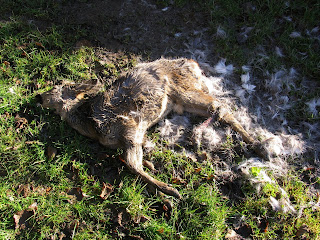
Yesterday as you are all aware was Saturday, the day I fire up my car and zoom off to work to earn an honest buck in order to keep myself and beer as close friends. Now, the day was fairly unspectacular (other than the freezing cold conditions) until it got to around 1400, when one of the shotgun coaches said to the three people he had just been tutoring “Ah, here’s the chap you want to speak to.” as I wandered past. One of the gentlemen proceeded then to tell me that he had a big cat in his area (Taunton) and that it was killing sheep.
This is very interesting indeed, and I have exchanged emails with one of the chaps who will provide me with photos when he can. I intend to get up there as soon as I can. This is probably not the same cat that I have been dealing with closer to home, but 25 miles away as the Raven flies (or as the Leopard runs for that matter) is, although seemingly large, not completely out of the question. Remember, an ABC in the wild would probably not have a territory this large, but this is not their wild habitat (with the possible exception of Lynxes). We have no idea how they behave when their prey is confined to a comparatively small area of land and are fairly easy to catch and kill. Will their territory size increase? My feeling is that yes it will do. Territory size is controlled mainly by two factors, how many competitors there are nearby, and how much food there is nearby. So, taking a Leopard as an example, lots of Hyenas and Lions around will diminish its territory size, and lots if easy to catch prey with a high nutrition value will again, diminish it. Few competitors and hard to catch, low energy prey (rabbits for instance) will both increase territory size. Note, low energy prey is prey that may be low in calorific content (or whatever measure of nutrition you want to use), but also take a lot of effort and energy to catch. For a Leopard of 80kg, a Rabbit which might get to 1kg is much more energy intensive to catch and eat than it is for a 10kg Fox, hence why Foxes take a lot of Rabbits.
Here in the UK, we can see a large amount of easy prey (expected to reduce territory size), but a low population density and little competition (expecting to increase territory size). I would expect with the evidence available to me that 25 miles for a territory is not as mad as it may at first seem for a Leopard/Puma/whatever. Just to err on the side of caution however, I would say that this is not the same cat.
Now, that lot is good for a day’s work. However, it gets better. I got home, showered, ate tea and then went onto the computer to write an article about keeping beetles for Exotic Pets magazine. I went onto an invertebrate’s forum, (on which I am the moderator of the beetles, aquatics and cockroaches sections) to check how things had been over the last day, and what did I find? Someone had posted a thread in Off Topic about big cats in Britain. Obviously I looked at it, and I was really surprised at what I found (I will not repeat the thread here, but you can go and look at it if you sign up as a member for Bug Nation).

As for that thing about the Beast, well, it is a little tradition I have.



















